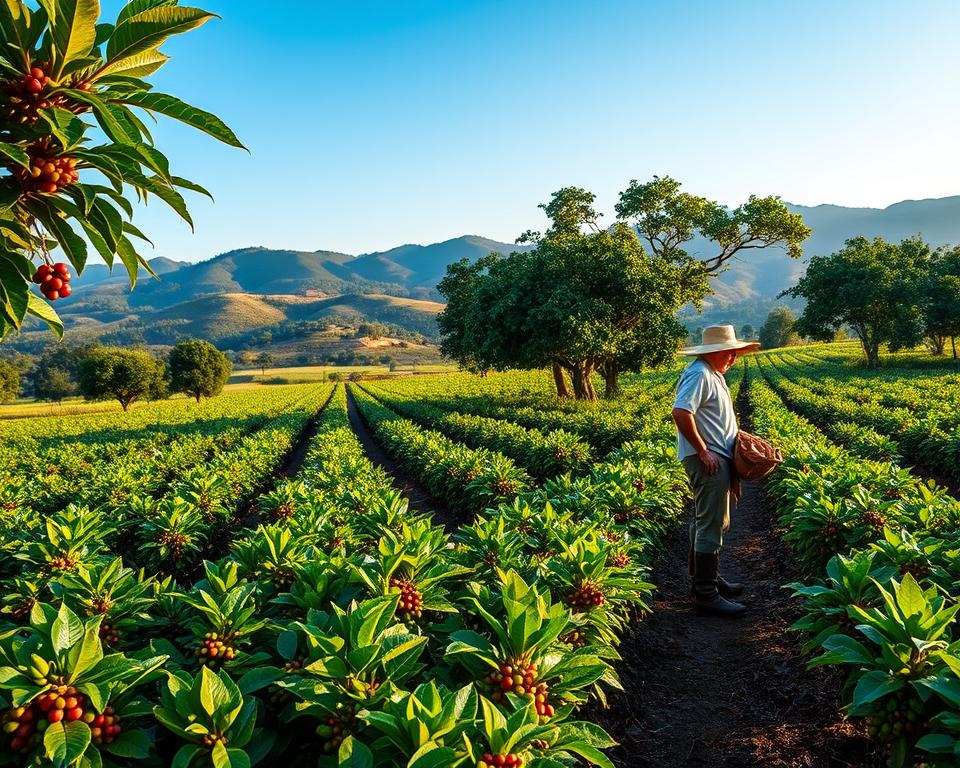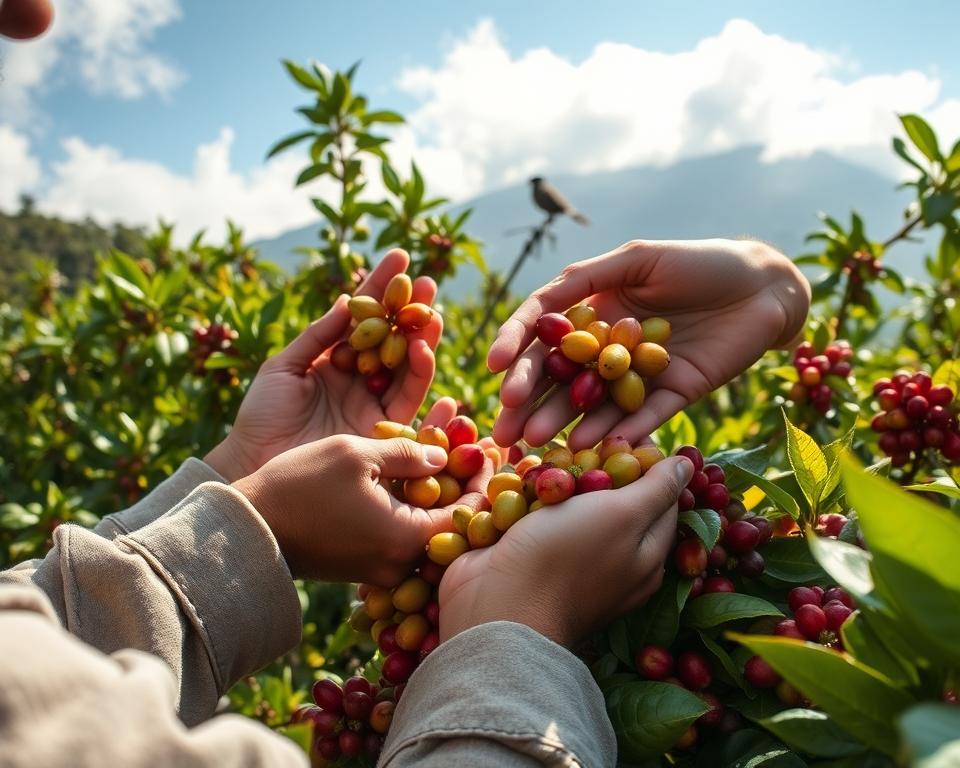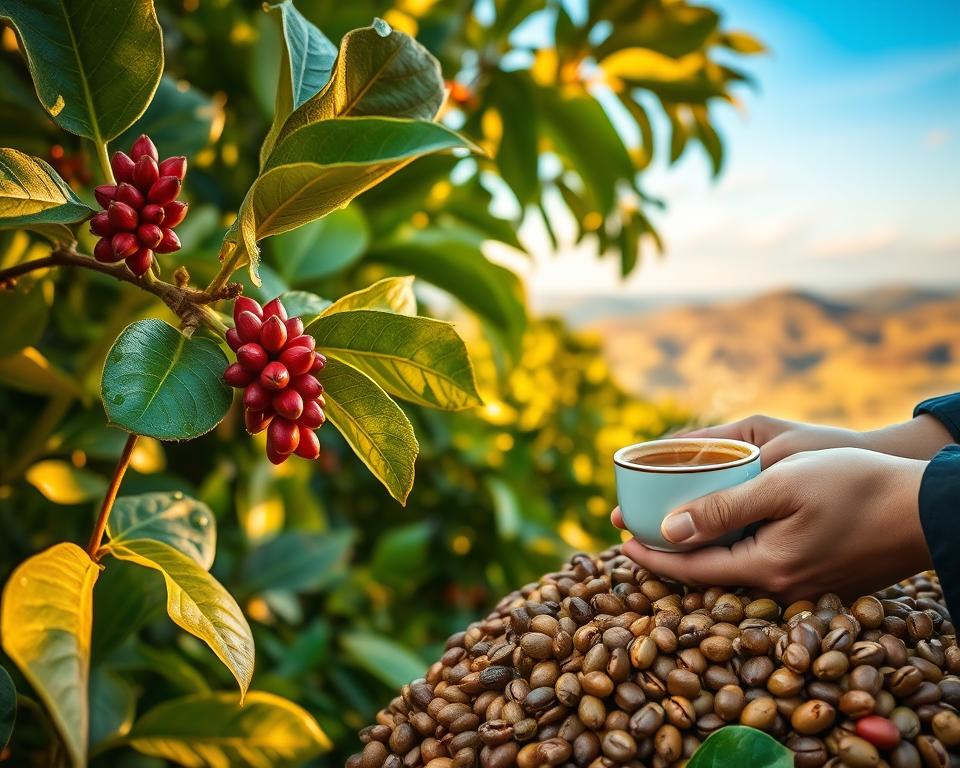Coffee quality is more than just personal taste; it’s deeply rooted in the environment where beans grow. With global consumption nearing 177 million 60-kilogram bags in 2023, the impact is significant. Rising temperatures and unpredictable weather are reshaping how coffee plants grow, affecting the premium coffee flavor we love. From droughts in Central America to changes in rainfall, climate conditions play a crucial role in whether beans develop their unique taste or decline.
Younger generations, like Gen Z starting coffee at 15, face a future where 50% of premium coffee farmland may disappear by 2050. Arabica beans, which make up 60% of global production, need specific 14°–26°C temperatures to thrive. But hotter, drier climates disrupt this balance, reducing yields and flavor complexity. Even altitude matters: lower altitudes and harsh light exposure can strip away desirable sensory traits, as studies show.
Key Takeaways
- Climate shifts threaten 50% of premium coffee-growing lands by 2050.
- Arabica beans require strict temperature ranges to maintain top coffee quality.
- Gen Z’s early coffee consumption habits face a future of scarcity and price hikes.
- Unpredictable weather disrupts flavor profiles, impacting acidity and aroma.
- Global warming could push coffee prices up, making today’s $5 latte seem affordable.
Understanding Coffee Quality
Coffee’s excellence begins with its measurement. Quality coffee beans are evaluated by strict standards, like the Specialty Coffee Association’s (SCA) Green Arabica Classification System (GACCS). This system assesses defects, moisture content, and screen sizes to ensure consistency. High-grade coffee demands beans without primary defects like mold or insect damage, ensuring each batch meets elite benchmarks.
What Defines Coffee Quality?
Quality is defined by three pillars: defects, physical traits, and sensory scores. Screen sizes also play a role, with Kenya AA beans being more expensive than Kenya AB due to their larger size. The SCA’s GACCS rejects batches with over 5 secondary defects per 300g sample. Moisture levels under 12% prevent spoilage, while density impacts roasting uniformity.
The Role of Flavor Profiles
Flavor is shaped by compounds like caffeine and chlorogenic acids. Acidity can range from bright (like citrus) to muted, while body can vary from light (like tea) to syrupy. Sweetness hints at fruit or caramel, and aftertaste leaves a lasting impression. These traits are key in the cupping protocol’s scoring criteria, determining if beans qualify as specialty-grade.
Importance of Aroma in Coffee
Aroma accounts for 70% of flavor perception. Volatile compounds like esters and aldehydes create floral or nutty notes. High-grade coffee retains these compounds through proper storage, while poor handling can dull them. Even a slight musty scent can downgrade quality coffee beans, making aroma a critical checkpoint for roasters and baristas.
Key Climate Factors Affecting Coffee
Climate is not just a backdrop for coffee plants—it’s the silent architect of quality. Every shift in temperature, rain, or humidity shapes the flavors that end up in your cup. Let’s explore how these elements create the best coffee beans and top-notch coffee selection.
Temperature Variability and Its Effects
Arabica coffee thrives between 14–26°C, where sugars and acids develop perfectly. Too cold? Beans freeze. Too hot? They burn out, losing brightness. Farmers in Colombia adjust planting schedules to dodge frost or heatwaves, protecting delicate cherries. These precise conditions make regions like Ethiopia’s highlands famous for their floral notes.
Precipitation Patterns and Coffee Growth
- Annual rainfall needs 1,000–2,700mm—enough to nourish roots but not drown them.
- Too little rain? Beans shrink, making bitter brews. Too much? Fungal diseases spread.
- Annual rainfall needs 1,000–2,700mm—enough to nourish roots but not drown them.
- Too little rain? Beans shrink, making bitter brews. Too much? Fungal diseases spread.
In Guatemala, timed rains boost bean density, creating the rich bodies in their top-notch coffee selection. Drought-stricken Brazil saw 20% yield drops in 2022, proving balance is key.
Humidity’s Role in Coffee Development
Humidity levels aren’t just about comfort—they’re a battlefield against mold. Ideal humidity (60–70%) lets cherries dry evenly after harvest. Too wet? Mildew ruins beans. Too dry? Aromas fade. Kenya’s misty slopes? Perfect for their iconic blackcurrant acidity.
“A 1°C rise in humidity can double fungal growth in coffee fields.” – International Coffee Organization
These factors mean top producers like Colombia and Costa Rica monitor weather obsessively. Even small shifts could turn a $5/lb specialty bean into a commodity blend. Stay tuned as we dive deeper into how altitude stacks the odds in section 4.
The Impact of Altitude on Coffee Quality
Specialty coffee roasters and gourmet coffee blends rely on elevation to shape taste and aroma. High-altitude beans thrive in climates where slower growth unlocks complex flavors. Let’s explore how elevation transforms ordinary beans into extraordinary brews.
Why Altitude Matters
Higher altitudes create cooler, slower-growing conditions that craft premium coffee. Here’s how it works:
- Temperatures drop 0.6°C every 100 meters climbed, slowing maturation and boosting acidity.
- Beans grown above 1,200m develop denser structures, retaining sugars for brighter, fruitier flavors.
- Arabica beans at 1,370m+ (like Guatemala’s Strictly Hard Bean) have 1.9mg caffeine vs robusta’s 2.9mg at lower altitudes.
Effects of High-Altitude Farming
Rugged terrain and thin air make high-altitude farming tough—but the payoff is worth it:
- Beans above 1,800m develop floral or citrus notes, while lower-grown coffees taste milder, like Brazil’s nutty 1,060m beans.
- Gourmet coffee blends prioritize high-altitude beans for their complexity, even with slower harvests and smaller yields.
- Specialty roasters highlight elevation on packaging, as higher altitudes cut caffeine and boost density, creating premium brews.
High-altitude coffees command premium prices due to their rarity and taste. For example, Ethiopia’s 1,800m+ beans boast floral profiles, while Papua New Guinea’s “Mile High” beans thrive in frost-free zones. Each meter climbed adds depth, making elevation a brewer’s secret weapon.
Soil Composition and Climate Interaction
Healthy soil and a favorable climate are crucial for exceptional coffee. Artisanal coffee roasters often highlight terroir details on their packaging. They show how soil and weather shape the beans’ journey from farm to cup. Quality coffee beans depend on balanced soil chemistry, which varies widely based on regional climates.
Nutrient Cycling in Different Climates
Climate zones dictate how nutrients move through soil. In tropical regions with heavy rainfall, nutrient leaching is common:
- Clayey soils retain nutrients but risk waterlogging, altering bean density
- Sandy soils lose nitrogen quickly, affecting sweetness levels
- Loamy soils maintain ideal moisture/nutrient balance for complex flavors
How Soil Health Influences Coffee Quality
Key minerals directly shape cup characteristics. A 2019 Ethiopia study revealed:
| Mineral | Impact |
|---|---|
| Nitrogen | Influences acidity and bitterness |
| Phosphorus | Enhances floral aromas |
| Potassium | Determines body and sweetness |
“Soil fertility parameters explained 84% of specialty quality variation in Ethiopian farms.” – 2023 Coffee Science Report
Artisanal coffee roasters increasingly test soil pH levels. Ideal pH (5.5-6.5) ensures minerals like magnesium and calcium stay bioavailable. When pH drops below 5.5, beans develop earthy flavors; above 7, acidity flattens. Premium quality coffee beans from Yirgacheffe owe their floral notes to volcanic loam rich in phosphorus and potassium.
Pest and Disease Pressure from Climate Change
Rising temperatures and changing weather patterns are causing pest and disease outbreaks that threaten coffee quality. In regions like Central America, prolonged droughts or erratic rainfall create ideal conditions for pests. Insects such as the coffee berry borer and leaf miner multiply quickly, spreading to new areas. A study shows these pests harm bean development, leading to defects that reduce flavor complexity.
Common Pests Expanding Their Reach
Warmer winters now allow pests to move beyond their traditional zones. The coffee berry borer, once limited to lowland farms, now invades higher altitudes. In Colombia, farmers face increased infestations, with beetles surviving year-round. This expansion forces growers to use more pesticides, increasing costs and risking chemical residues in beans—a major concern for specialty coffee roasters focused on purity.
Diseases Pushing into New Territories
Coffee leaf rust, a fungus that has plagued crops since the 19th century, now reaches cooler highlands. Brazil’s 2021 frost damaged 20% of crops, but rising temperatures paradoxically worsen rust outbreaks in Guatemala and Kenya. Diseased plants produce smaller, less flavorful beans as they divert energy to survival rather than flavor compound production.
Specialty coffee roasters are working with farmers to plant resistant varieties like the Rust-Resistant Timor Hybrid. These partnerships ensure beans retain the acidity and aroma that discerning drinkers demand, even as climate pressures intensify.
Sustainable Farming Practices
Adapting to climate shifts without sacrificing quality means embracing sustainable methods. These practices protect ecosystems while maintaining the best coffee beans and high-grade coffee. Innovations like shade-grown systems and water conservation turn challenges into opportunities for resilient harvests.

Adaptive Strategies for Climate Resilience
Shade-grown coffee farms balance productivity and ecology. By planting canopy trees, farmers reduce temperature extremes while boosting biodiversity. For example, the Cooperativa de Caficultores de Antioquia in Colombia uses this method to nurture complex flavor profiles in beans. Research shows shade cover between 30–45% optimizes yields without sacrificing bean quality.
Shade cover above 50% can significantly limit coffee yields, while 30–45% shade cover promotes the highest yields. — Soto-Pinto et al., 2000
- Shade trees provide natural pest control, reducing chemical use
- Agroforestry systems sequester carbon, cutting emissions
- Microclimates from shade systems protect against temperature spikes
Rainwater Harvesting Techniques
Managing water smartly ensures beans mature evenly. Vietnam’s Central Highlands, where 95% of Robusta grows, faces drought risks. Techniques like drip irrigation and rainwater storage help farmers survive dry seasons. Starbucks’ C.A.F.E. Practices and Nespresso’s AAA Program fund infrastructure like reservoirs, aiding farms in Laos and Brazil.
Techniques like contour farming and terracing prevent soil erosion. In Lăng Cú village, 25% of farmland now uses these methods, boosting bean consistency. By 2050, such practices could safeguard 79% of coffee regions from heat stress, according to World Coffee Research.
The Role of Microclimates
Microclimates are nature’s tiny climate zones, influencing how coffee cherries grow. These localized environments, formed by hillsides, forests, or water sources, create unique conditions. They transform ordinary beans into premium coffee flavor sensations. A closer look at these small-scale climates reveals the magic behind the world’s best brews.
What Are Microclimates?
Picture a farm where a sun-dappled slope meets a shaded valley. Each spot has its own microclimate. These pockets, influenced by terrain and vegetation, can change even within a few meters. As explained in this study, microclimates impact bean density, acidity, and aroma. For coffee farmers, mapping these zones is like solving a puzzle to unlock exceptional taste.
How Microclimates Enhance Coffee Quality
Consider these examples of microclimate magic:
- Ethiopian Yirgacheffe: Cool mountain breezes and volcanic soils craft its tea-like brightness and floral hints.
- Colombian Supremo: Andean valleys’ varied shade patterns slow bean maturation, amplifying berry and caramel notes.
- Hawaiian Kona: Pacific sea breezes and mineral-rich soils create a smooth, sweetly complex cup.
These tiny climate zones also protect against extremes. Shaded microclimates, like those in Costa Rica’s cloud forests, shield plants from sunburn while boosting acidity. Even rainfall plays a role—too little stress plants, but balanced moisture in places like Guatemala’s Antigua region fosters the gourmet coffee blends that dominate specialty markets.
Harvest Timing and Climate Influence
Timing is everything for coffee quality. Artisanal coffee roasters need precise harvest windows to get the top-notch coffee selection they desire. But, climate shifts are altering these schedules.

| Region | Harvest Season |
|---|---|
| Brazil | May-September |
| Kenya | October-December |
| Colombia | March-July |
Rising temperatures are shortening traditional harvest windows. Unpredictable rains delay drying, while heatwaves speed up ripening. In 2012, Central America saw an 85% loss of crops to leaf rust during disrupted harvests. This forces farmers to adjust planting and picking strategies.
- Warmer winters reduce chill hours needed for flowering
- Early rains trigger premature ripening
- Increased pest activity during atypical weather
Artisanal coffee roasters now partner with farmers to track weather in real-time. They invest in shade-grown methods and drought-resistant varieties. These efforts ensure quality remains consistent despite changing conditions.
Small changes in harvest timing can greatly affect coffee quality. As climates evolve, the need to protect this balance grows.
Regional Case Studies
Climate shifts are dramatically altering the landscapes of high-grade coffee and quality coffee beans across the globe. This section delves into how three pivotal regions are adapting to these changes. They aim to safeguard the distinct flavors that have made their coffee renowned.
Coffee in Central America
In Nicaragua and Guatemala, the effects of rising temperatures and unpredictable rainfall are evident. These changes are disrupting the bright acidity that is a hallmark of their quality coffee beans. To counteract these issues, farmers are turning to higher altitudes for their plantings. This strategy helps combat droughts and hurricanes, though El Niño events continue to pose a threat to their harvests.
As a result, growers are adopting shade-grown methods. This approach helps stabilize yields and mitigate the impact of climate variability.
Coffee in East Africa
Ethiopia, the world’s third-largest Arabica producer, is experiencing changes in its climate. These shifts are affecting the floral and fruity notes in its high-grade coffee. Kenya’s renowned AA beans are also facing challenges due to temperature fluctuations. These changes are blurring the traditional flavor profiles of these beans.
To address these issues, farmers in Kenya are experimenting with drought-resistant varieties. This move is aimed at preserving their reputation in the specialty coffee market.
Coffee in South America
Brazil and Colombia, together accounting for 50% of global Arabica production, are facing unique challenges. Brazil’s 2021-22 harvest saw a 7.6% decline due to frosts and droughts. Colombia, on the other hand, is experiencing warming in its mild climates. Both countries are prioritizing the use of shade trees and water-saving technologies.
These efforts are crucial for maintaining the consistency of their quality coffee beans in the face of rising threats.
The Future of Coffee Quality Amid Climate Change
Climate change is a major threat to coffee’s taste and availability. Yet, there’s hope through innovation. By 2050, up to 50% of current coffee-growing land might become unsuitable, jeopardizing the quality of the best coffee beans. Specialty coffee roasters are already taking action, working with farmers to ensure quality despite the rising risks.
Experts predict that flavor profiles could change significantly. Higher temperatures might reduce acidity in Arabica beans, affecting the vibrant notes that coffee lovers enjoy. To preserve these flavors, specialty coffee roasters are expanding their sourcing networks and investing in climate-smart partnerships. The WCR’s 2023 report emphasizes the urgent need for $452 million annually to maintain quality as land availability shrinks.
“By 2050, suitable land for Arabica coffee could be halved due to climate change.”
- Climate-resistant varietals are being bred to thrive in hotter, drier conditions.
- Smart irrigation systems reduce water use while maintaining crop health.
- Shade-grown techniques protect coffee plants from extreme sun exposure.
Starbucks has distributed over 3 million climate-resistant seeds to farmers, aiming to balance resilience with quality. WCR’s Innovea program is testing 100 new varieties across 10 countries, ensuring future best coffee beans meet both taste and climate needs. These efforts align with specialty coffee roasters pushing for sustainable practices.
While challenges loom, collaboration between growers, researchers, and roasters offers a path forward. The coffee community’s innovative spirit is crafting a future where quality and resilience coexist.
Conclusion: The Path Forward for Quality Coffee
Securing the future of premium coffee flavor demands immediate action across the supply chain. Every step, from farms to roasteries, shapes the drink’s resilience. The industry is adapting to protect coffee’s exceptional qualities.
Importance of Climate Resilience
Building systems that balance yield and quality is crucial for climate resilience. Innovations like near-infrared spectroscopy (NIRS) track bean health. Sustainable practices, such as reduced chemical use, safeguard flavor.
Farmers adopting organic methods and high-altitude shade-growing preserve quality. These steps also reduce risks like mycotoxin contamination. This ensures beans stay safe and flavorful.
Coffee Community’s Response to Change
Collaboration drives progress in the coffee industry. The Specialty Coffee Association’s (SCA) standards now align with digital tasting tools. This ensures top-notch coffee selection.
Certifications like Rainforest Alliance and Fair Trade connect drinkers to farms using ethical practices. Consumers can boost demand for quality by choosing certified beans. This supports farmers who use organic methods and adopt climate-smart tools. This shift protects flavor and strengthens communities.
FAQ
How does climate affect coffee quality?
What defines quality coffee beans?
Why is aroma important in coffee?
How does altitude impact coffee quality?
What are microclimates, and how do they affect coffee?
What sustainable practices can help maintain coffee quality?
How do pests and diseases impact coffee quality?
Why is the timing of coffee harvest important?
How is soil health related to coffee quality?
What innovations are being developed to ensure coffee quality amid climate change?

Paul Allen is a writer at WyNeeds, a website dedicated to the world of coffee. Passionate about aromas and flavors, he explores everything from the best brewing methods to fascinating insights about coffee beans and industry trends. His goal is to provide readers with engaging and informative content, helping both beginners and coffee enthusiasts deepen their knowledge of the world’s most beloved beverage.

